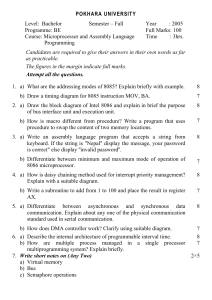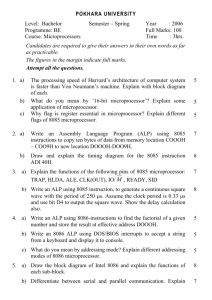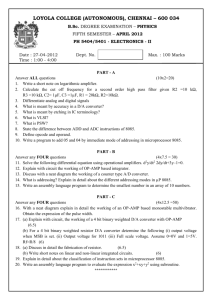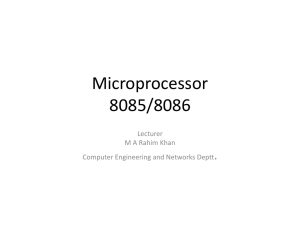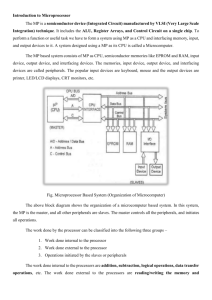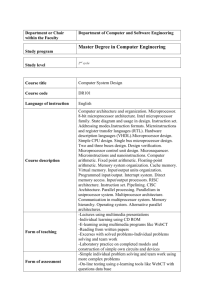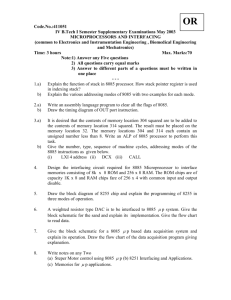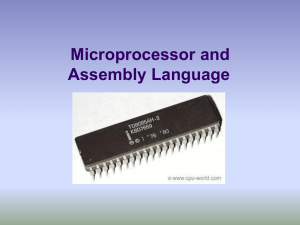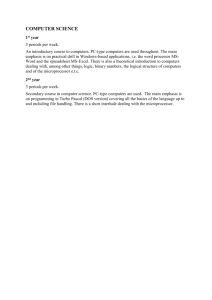Microp_102409011048_1
advertisement
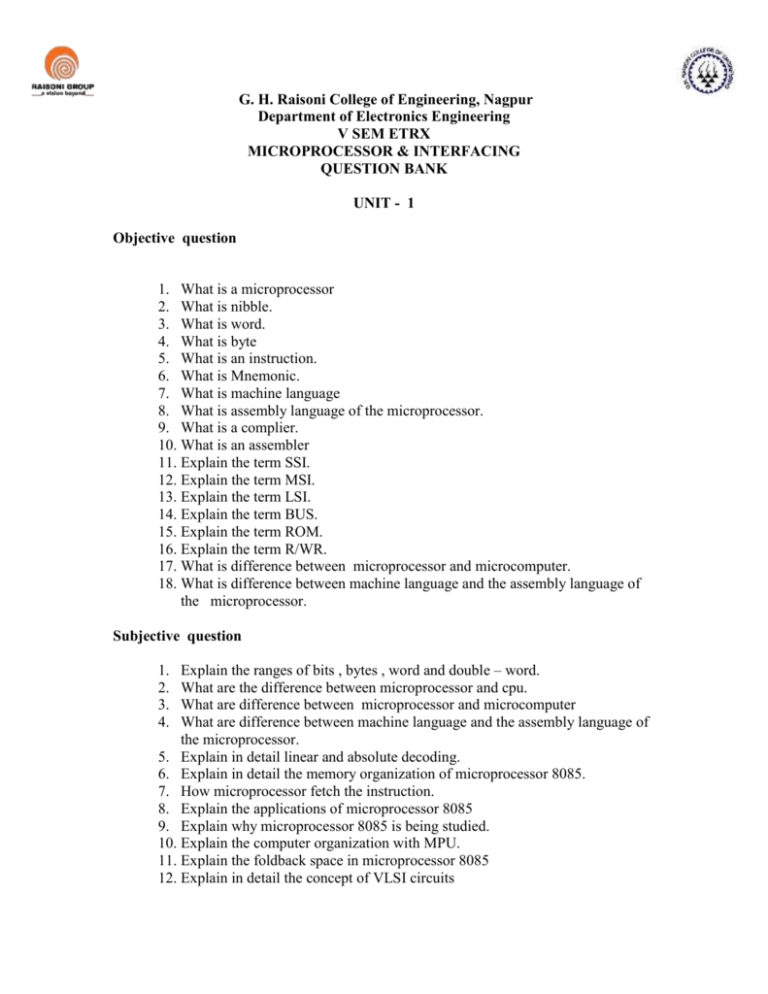
G. H. Raisoni College of Engineering, Nagpur Department of Electronics Engineering V SEM ETRX MICROPROCESSOR & INTERFACING QUESTION BANK UNIT - 1 Objective question 1. What is a microprocessor 2. What is nibble. 3. What is word. 4. What is byte 5. What is an instruction. 6. What is Mnemonic. 7. What is machine language 8. What is assembly language of the microprocessor. 9. What is a complier. 10. What is an assembler 11. Explain the term SSI. 12. Explain the term MSI. 13. Explain the term LSI. 14. Explain the term BUS. 15. Explain the term ROM. 16. Explain the term R/WR. 17. What is difference between microprocessor and microcomputer. 18. What is difference between machine language and the assembly language of the microprocessor. Subjective question Explain the ranges of bits , bytes , word and double – word. What are the difference between microprocessor and cpu. What are difference between microprocessor and microcomputer What are difference between machine language and the assembly language of the microprocessor. 5. Explain in detail linear and absolute decoding. 6. Explain in detail the memory organization of microprocessor 8085. 7. How microprocessor fetch the instruction. 8. Explain the applications of microprocessor 8085 9. Explain why microprocessor 8085 is being studied. 10. Explain the computer organization with MPU. 11. Explain the foldback space in microprocessor 8085 12. Explain in detail the concept of VLSI circuits 1. 2. 3. 4. 13. Explain in detail the embedded system. 14. Design the memory system for 8085 microprocessor to provide the storage capacity for permanent data using 16KX8 EPROM by using 8KX8 EPROM and 32KX8 RAM by using 8KX8 RAM the RAM address is 4000H. Draw suitable diagram. 15. Design the memory system for 8085 microprocessor to provide the storage capacity for permanent data using 8KX8 EPROM by using 4KX8 EPROM and 16KX8 RAM by using 4KX8 RAM the RAM address is 6000H. Draw suitable diagram 16. Explain memory organization with suitable diagram and how 17. maximum memory of the 8085 is decided. UNIT - 2 Objective question 1. What is the function of accumulator. 2. What is the function of stack pointer. 3. What is the function of program counter. 4. What is the function of flag register. 5. What is the function of ALU. 6. What is the function of instruction register. 7. What is the function of interrupt control unit. 8. What is the function of serial input output control. 9. What is the function of increment and decrement register. 10. What is the function of instruction decoder unit. 11. What is the function of timing and control unit. 12. What is the function of temporary register. 13. What is the function of address buffer. 14. What is the function of data buffer. 15. What is the flag. 16. What is carry flag. 17. What is auxiliary carry flag. 18. What is parity flag. Subjective question 1. Explain the architecture of microprocessor 8085 in detail. 2. Draw the pinout diagram of 8085 microprocessor . 3. Explain all the pins of 8085 microprocessor 4. Why data bus is bi-directional 5. What are the function of address bus and the direction of address bus 6. What are the different addressing modes. 7. How the instructions are classified. 8. What is the de-multiplexing of bus AD7-AD0. 9. What is the immediate addressing mode explain with suitable example. 10. What is the register direct addressing mode explain with suitable example 11. What is the direct addressing mode explain with suitable example. 12. What is the register indifferent addressing mode explain with suitable example. 13. What is the implicit addressing mode explain with suitable example 14. Classify the instructions according to the number of bytes. 15. Draw a timing diagram of the instruction MOV A, M and explain in detail. 16. Draw a timing diagram of the instruction MOV A, M and explain in detail. 17. Draw the timing diagram of IN instruction. 18. Draw the timing diagram of OUT instruction UNIT – 3 Objective question 1. What is sign flag. 2. What is zero flag. 3. What is the significance of ALE pin. 4. What is the function of IO/M signal. 5. How u find the memory read and IO read signal. 6. How u find the memory write and IO write signal. 7. What is function of X1, X2. 8. What is function of CLK out signal. 9. What is function of READY signal. 10. What is function of RD signal. 11. What is function of WR signal. 12. What is function of ALE signal. 13. What is function of S0,S1 signal. 14. What is function of HOLD signal. 15. What is function of HLDA signal. 16. What is function of RESET IN signal. 17. What is function of RESET OUT signal. 18. What is function of INTR signal. Subjective question 1. What is the flag and explain all the flags. 2. Explain in brief status flag available in 8085 & how they are useful for the programmer. 3. Write an ALP to add the string of 100 bytes which is present in the 4. location 5000H and result is stored in the memory location 6000H. 5. Explain ALU, Program counter, Stack pointer 6. Explain General-purpose register, PSW, Interrupt control 7. Explain the execution of an instruction 8. Explain in detail LDAX, LHLD, CPI, ADC M, LDA 9. Explain the memory organization 10. Explain in detail SUI, LXI, STA, SBB M, CMP M. 11. Two numbers P& Q are stored at 2050H & 2051H locations. logically NAND the numbers & store result in D register 12. Differentiate between the CALL & JMP instruction 13. Draw the detailed block dia. of 8255 PPI. Explain mode 0, mode1, operation Also give the format of BSR word in 8255 to set pc4 bit. 14. Interface stepper motor to 8085 using 8255. Interface motor in half power mode in clockwise direction. Assume and degree of rotation 15. Draw the complete interfacing diagram of interfacing 8 bit DAC 0808 to an 8085 microprocessor using 8255 16. Write an ALP to add ten 8 bit nos. present in the memory location whose address is present in the Register pair BC & result is store in DE pair. 17. Write an ALP to inter change the data of ten 8 bit present in memory location C000H &D002H UNIT – 4 Objective question 1. What is function of SID signal. 2. What is function of SOD signal. 3. What is function of MOV Rd, Rs. 4. What is function of MVI R, 8bit data. 5. What is function of OUT 8 bit data. 6. What is function of IN 8 bit data. 7. What is function of ADC R 8. What is function of ADC M. 9. What is function of ADI 8bit data. 10. What is function of ACI 8bit data 11. What is function of INR R. 12. What is function of INR M. 13. What is function of ANA R. 14. What is function of ANA M. 15. What is function of ANI 8bit data. 16. What is function of CMA. Subjective question 1. What are the different types of interrupts in 8085 microprocessor 2. Draw and explain the interrupt structure of 8085 microprocessor. Show clearly priority, input triggering, masking, vector locations, enabling, disabling , etc. 3. What is the use of SID and SOD pin in 8085 4. Explain RIM,SIM instruction. 5. Explain EI, DI instruction 6. Explain the hardware interrupts and classify them according to the priority 7. Explain the software interrupts and give the differences between hardware interrupt 8. What do you mean by vectored interrupt 9. Explain in detail about maskable and non- maskable interrupts 10. Explain the instruction RSTn 11. Explain INTR instruction in detail and give the difference from other hardware interrupts. 12. Differentiate between PUSH and POP instructions 13. What is stack? Explain the use of stack & stack pointer. Explain the related instructions. 14. What is subroutine? Explain the related instructions 15.Explain the meaning of pending interrupts 16. A number is present in register B.Set the D1 & D3 bits of the no., without disturbing the other bits. Restore the no. in register B 17. WAP to separate odd & even nos from an array of 10 nos stored from 2050H.Store the odd nos. from 2060H & even from 2070H onwards UNIT – 5 Objective question 1. What is function of RLC. 2. What is function of RAL. 3. What is function of RRC. 4. What is function of RAR. 5. What is function of CMP R. 6. What is function of CMP M. 7. What is function of CPI 8 bit data. 8. What is function of JMP Address. 9. What is addressing mode of XCHG. 10. What is addressing mode of PCHL. 11. What is addressing mode of SHLD. 12. What is addressing mode of LHLD. 13. What is addressing mode of RIM. 14. What is addressing mode of SIM. 15. What is addressing mode of DAA. 16. What is addressing mode of EI. Subjective question 1. Port A of the 8255 A is set up in mode 1, and the status word is read as 18H Explain the block diagram of 8255 PPI & describe each block in detail . 2. Explain the control words for BSR mode 8255. 3. Explain the parallel IO mode of 8255. 4. Explain the various types of asynchronous parallel data transfer 5. Explain in detail the interfacing of an input device with microprocessor 8085 6. Explain in detail the interfacing of an input device with microprocessor 8085 7. Explain data transfer using handshake signals 8. Explain bi-directional data transfer using handshake signals 9. Design an interfacing circuit to read data from an A/D converter, using the 8255A in the memory – mapped I/O. 10. Specify the handshake signals and their functions if port A of the 8255A is set up as an output port in mode 1.Is there an error in the status word? 11. Two numbers P& Q are stored at 2050H & 2051H locations. Logically NAND the numbers & store result in D register 12. WAP to separate odd & even nos from an array of 10 nos stored from 2050H.Store the odd nos. from 2060H & even from 2070H onwards 13. Two 16 bit numbers, P and Q are present in the BC and DE register pairs, respectively. Add the two numbers and store the result in HL pair 14. Two 16 bit numbers, P and Q are stored from locations 2000H onwards. Subtract the number Q and P and store the result in BC pair 15. WAP to convert a given 8 bit binary number stored at 2050H into equivalent gray number. Store the gray number at the same location. 16. Three 8 bit numbers P,Q and R are stored in the B, C and D registers respectively. Find the largest number and store it in the H register UNIT – 6 Objective question 1. What is addressing mode of DI. 2. What is addressing mode of CMA. 3. What is addressing mode of NOP. 4. What is addressing mode of HLT. 5. What is function of CALL. 6. What is function of RET. 7. What is function of XTHL. 8. What is function of SPHL. 9. What is function of POP Rp. 10. What is function of PUSH Rp. 11. What is function of XCHG. 12. What is function of PCHL. 13. What is function of SHLD. 14. What is function of LHLD. 15. What is function of RIM. 16. What is function of SIM 17. What is function of DAA. 18. What is function of EI. 19. What is function of DI. Subjective question 1. 2. 3. 4. Explain the assembler directives. Define pseudo instruction. Explain the concept of bus contention. Why are assembler directives called as pseudo opcodes or pseudo instructions of microprocessor 8085 5. Explain how bus contention can be avoided? 6. Explain the use of buffer 7. WAP to generate a square wave of 100Hz frequency on the SOD pin. Assume 1MHz Operating frequency 8. WAP to receive a serial data on SID line. The data format is as in the previous examples 9. Interface a 4* 4 keyboard to the microprocessor. WAP to detect a key closure and store the keycode. 10. WAP to rotate the stepper motor in clockwise direction by 360 degree & then in anticlockwise direction by 180 degree. The full-step movement of the motor is 1.8 degree. 11. Explain key debounce using hardware 12. Explain key debounce using software 13. WAP to count continuously in binary with a one second delay between each count. Write a service routine at 2070H to flash FFH five times when the program is interrupted, with some appropriate delay between each flash. 14. Interface ADC with 8085 microprocessor. 15. Interface DAC with 8085 microprocessor 16. Interface the 8-key keyboard of previous example in the memory mapped I/O. Display the key code on LEDs 17. interface an 8-key keyboard to the microprocessor in I/O mapped I/O 18. How many ports are present in PIO 8255? 19. How port C works in PIO 8255? 20. How many modes are present in PIO 8255? 21. What is the function of BSR mode in PIO 8255? 22. In which application, BSR mode can be used? 23. What are the functions of mode1, mode2 and mode3? 24. Give the Control Word Format of 8255 in I/O and BSR mode.
